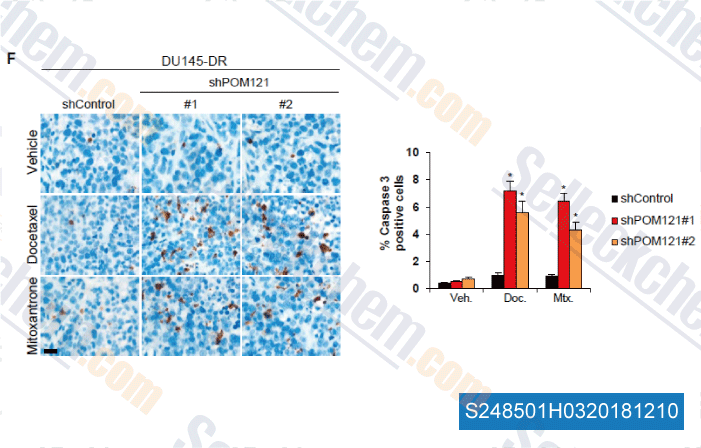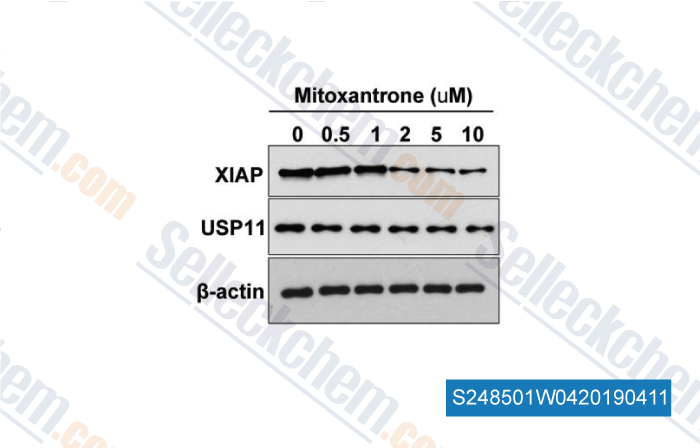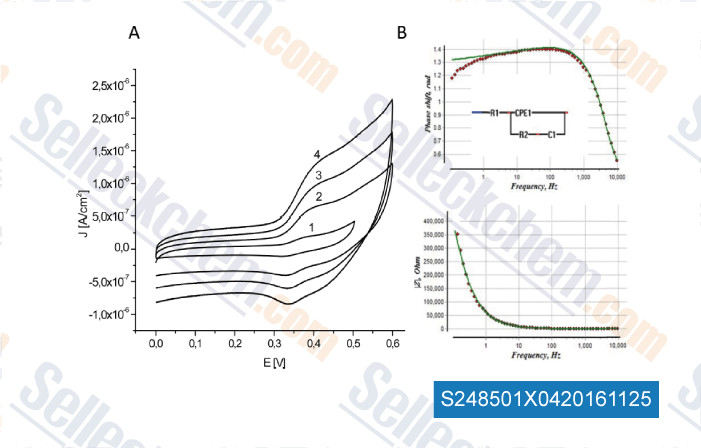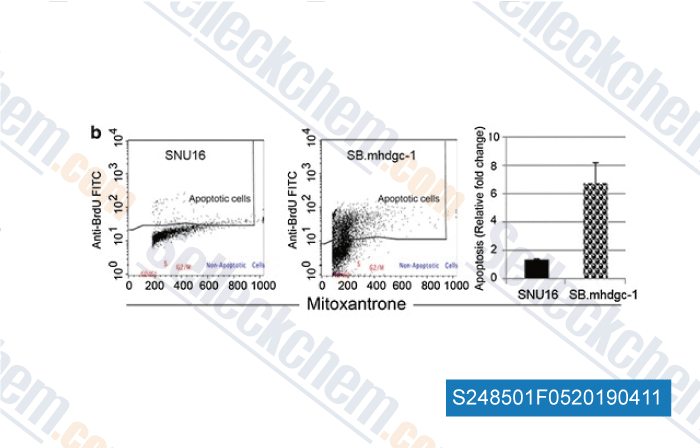|
Toll Free: (877) 796-6397 -- USA and Canada only -- |
Fax: +1-832-582-8590 Orders: +1-832-582-8158 |
Tech Support: +1-832-582-8158 Ext:3 Please provide your Order Number in the email. |
Technical Data
| Formula | C22H29ClN4O6.2HCl |
|||
| Molecular Weight | 517.4 | CAS No. | 70476-82-3 | |
| Solubility (25°C)* | In vitro | DMSO | 100 mg/mL (193.27 mM) | |
| Water | 100 mg/mL (193.27 mM) | |||
| Ethanol | Insoluble | |||
|
* <1 mg/ml means slightly soluble or insoluble. * Please note that Selleck tests the solubility of all compounds in-house, and the actual solubility may differ slightly from published values. This is normal and is due to slight batch-to-batch variations. * Room temperature shipping (Stability testing shows this product can be shipped without any cooling measures.) |
||||
Preparing Stock Solutions
Biological Activity
| Description | Mitoxantrone 2HCl is a dihydrochloride salt of Mitoxantrone. Mitoxantrone is an inhibitor of type II topoisomerase and protein kinase C (PKC) with IC50 of 8.5 μM for PKC. Mitoxantrone inhibits cell proliferative growth of MCF-7/wt cells with IC50 of 0.42 μM. Mitoxantrone also induces apoptosis. | ||||
|---|---|---|---|---|---|
| Targets |
|
||||
| In vitro | Mitoxantrone induces DNA fragmentation and the proteolytic cleavage of poly(ADP-ribose) polymerase (PARP), a marker of the activation of caspases, in all the patients studied, demonstrating that the cytotoxic effect of mitoxantrone is due to induction of apoptosis. [1] Mitoxantrone activates NFkappaB and stimulates IkappaBalpha degradation in the promyelocytic leukemia cell line HL60 but not in the variant cells, HL60/MX2 cells, which lack the beta isoform of topoisomerase II and express a truncated alpha isoform that results in an altered subcellular distribution. [2] Mitoxantrone inhibits proliferation of activated PBMCs, B lymphocytes, or antigen-specific T-cell lines (TCLs) stimulated on antigen-presenting cells (APCs) in a dose-dependent manner. Mitoxantrone induces apoptosis of PBMCs, monocytes and DCs at low concentrations, whereas higher doses causes cell lysis. [3] |
||||
| In vivo | Mitoxantrone transiently decreases the growth rate of HID xenografts in mice but does not affect that of PAC120 xenografts. [4] Mitoxantrone results in the severity of the cardiac lesions and the nephropathy and the intestinal toxicity in spontaneously hypertensive rats. Mitoxantrone and iron(III) form a strong 2:1 complex, in which mitoxantrone may be acting as a tridentate ligand. [5] |
Protocol (from reference)
References
Customer Product Validation

-
Data from [Data independently produced by , , Cell, 2018, 174(5):1200-1215]

-
Data from [Data independently produced by , , EBioMedicine, 2017, 15:48-61]

-
Data from [Data independently produced by , , Electrochimica Acta, 2015, 165:430-442.]

-
Data from [Data independently produced by , , J Transl Med, 2017, 15(1):92]
Selleck's Mitoxantrone 2HCl has been cited by 50 publications
| Deletion of the mitochondrial calcium uniporter in adipose tissue promotes energy expenditure and alleviates diet-induced obesity [ Mol Metab, 2024, 80:101873] | PubMed: 38199601 |
| Carbonic anhydrase IX inhibitor S4 triggers release of DAMPs related to immunogenic cell death in glioma cells via endoplasmic reticulum stress pathway [ Cell Commun Signal, 2023, 21(1):167] | PubMed: 37386564 |
| Development of Novel Epigenetic Anti-Cancer Therapy Targeting TET Proteins [ Int J Mol Sci, 2023, 10.3390/ijms242216375] | PubMed: 38003566 |
| A Novel Class of Ribosome Modulating Agents Exploits Cancer Ribosome Heterogeneity to Selectively Target the CMS2 Subtype of Colorectal Cancer [ Cancer Res Commun, 2023, 3(6):969-979] | PubMed: 37377612 |
| A positive feedback circuit between RN7SK snRNA and m6A readers is essential for tumorigenesis [ Mol Ther, 2022, S1525-0016(22)00717-1] | PubMed: 36566349 |
| Lysosomal sequestration of weak base drugs, lysosomal biogenesis, and cell cycle alteration [ Biomed Pharmacother, 2022, 153:113328] | PubMed: 35785701 |
| Regulatory Role of Sphingosine-1-Phosphate and C16:0 Ceramide, in Immunogenic Cell Death of Colon Cancer Cells Induced by Bak/Bax-Activation [ Cancers (Basel), 2022, 14(21)5182] | PubMed: 36358599 |
| A Gene Co-Expression Network-Based Drug Repositioning Approach Identifies Candidates for Treatment of Hepatocellular Carcinoma [ Cancers (Basel), 2022, 14(6)1573] | PubMed: 35326724 |
| Establishment and Characterization of NCC-PMP1-C1: A Novel Patient-Derived Cell Line of Metastatic Pseudomyxoma Peritonei [ J Pers Med, 2022, 12(2)258] | PubMed: 35207746 |
| Establishment and characterization of NCC-UPS4-C1: a novel cell line of undifferentiated pleomorphic sarcoma from a patient with Li-Fraumeni syndrome [ Hum Cell, 2022, 10.1007/s13577-022-00671-y] | PubMed: 35118583 |
RETURN POLICY
Selleck Chemical’s Unconditional Return Policy ensures a smooth online shopping experience for our customers. If you are in any way unsatisfied with your purchase, you may return any item(s) within 7 days of receiving it. In the event of product quality issues, either protocol related or product related problems, you may return any item(s) within 365 days from the original purchase date. Please follow the instructions below when returning products.
SHIPPING AND STORAGE
Selleck products are transported at room temperature. If you receive the product at room temperature, please rest assured, the Selleck Quality Inspection Department has conducted experiments to verify that the normal temperature placement of one month will not affect the biological activity of powder products. After collecting, please store the product according to the requirements described in the datasheet. Most Selleck products are stable under the recommended conditions.
NOT FOR HUMAN, VETERINARY DIAGNOSTIC OR THERAPEUTIC USE.
